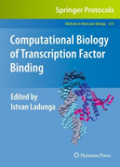
Through great experimental difficulty, we’ve witnessed rapid, crucial developments at the intersection of computational biology, experimental technology, and statistics through which the vital process of transcriptional regulation can be further examined. In Computational Biology of Transcription Factor Binding, experts in the field examine the basic principles and provide detailed guidance for the computational analyses and biological interpretations of transcription factor binding, while disclosing critical practical information and caveats that are missing from many research publications. The volume serves not only computational biologists but experimentalists as well, who may want to better understand how to design and execute experiments and to communicate more effectively with computational biologists, computer scientists, and statisticians. Written for the highly successful Methods in Molecular Biology™ series, this work provides the kind of detailed description and implementation advice that is crucial for getting optimal results in the lab. Authoritative and easy touse, Computational Biology of Transcription Factor Binding guides scientists working in this area and demands not only new experiments but also the re-annotation of existing experimental data and computational predictions leading to important ongoing, major paradigm changes for us all. -Guides scientists of all disciplines through the jungle of regulatory regions, ChIP-seq, about 200 motif discovery tools and others -Includes vital tricks-of-the-trade from experts well-versed in the technology whenever available -Provides cutting-edge p INDICE: An Overview of the Computational Analyses and Discovery of Transcription Factor Binding Sites.- Components and Mechanisms of Regulation of Gene Expression.- Regulatory Regions in DNA: Promoters, Enhancers, Silencers, and Insulators.- Three-Dimensional Structures of DNA-Bound Transcriptional Regulators.- Identification of Promoter Regions and Regulatory Sites.- Motif DiscoveryUsing Expectation Maximization and Gibbs’ Sampling.- Probabilistic Approachesto Transcription Factor Binding Site Prediction.- The Motif Tool Assessment Platform (MTAP) for Sequence-Based Transcription Factor Binding Site PredictionTools.- Computational Analysis of ChIP-seq Data.- Probabilistic Peak Calling and Controlling False Discovery Rate Estimations in Transcription Factor Binding Site Mapping from ChIP-seq.- Sequence Analysis of Chromatin Immunoprecipitation Data for Transcription Factors.- Inferring Protein-DNA Interaction Parameters from SELEX Experiments.- Kernel-Based Identification of Regulatory Modules.- Identification of Transcription Factor Binding Sites Derived from Transposable Element Sequences Using ChIP-seq.- Target Gene Identification via NuclearReceptor Binding Site Prediction.- Computing Chromosome Conformation.- Large-Scale Identification and Analysis of C-Proteins.- Evolution of cis-Regulatory Sequences in Drosophila.- Regulating the Regulators: Modulators of Transcription Factor Activity.- Annotating the Regulatory Genome.- Computational Identification of Plant Transcription Factors and the Construction of the PlantTFDB Database.- Practical Computational Methods for Regulatory Genomics: A cisGRN-Lexicon and cisGRN-Browser for Gene Regulatory Networks.- Reconstructing Transcriptional Regulatory Networks Using Three-Way Mutual Information and Bayesian Networks.- Computational Methods for Analyzing Dynamic Regulatory Networks.
- ISBN: 978-1-60761-853-9
- Editorial: Humana
- Encuadernacion: Cartoné
- Páginas: 415
- Fecha Publicación: 29/09/2010
- Nº Volúmenes: 1
- Idioma: Inglés
